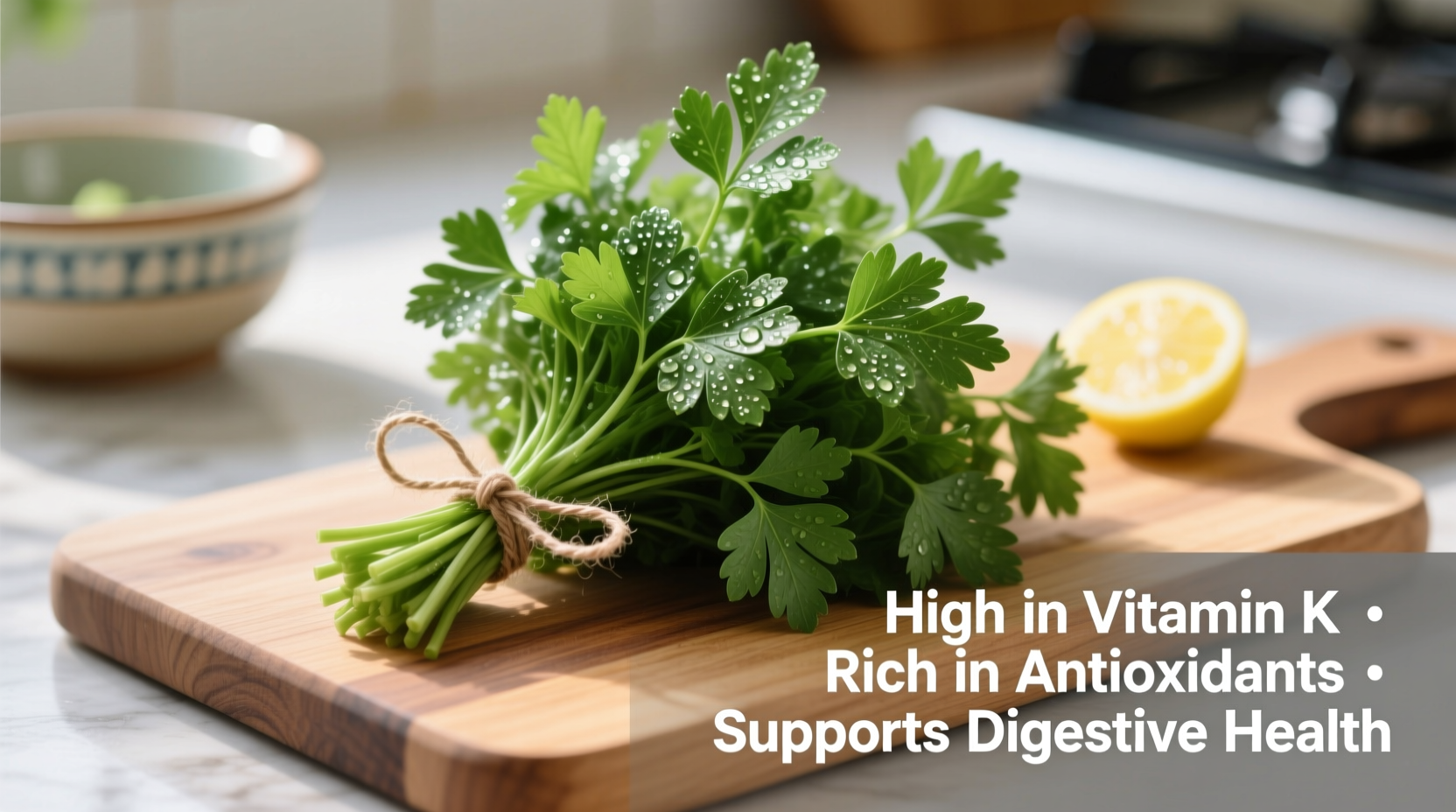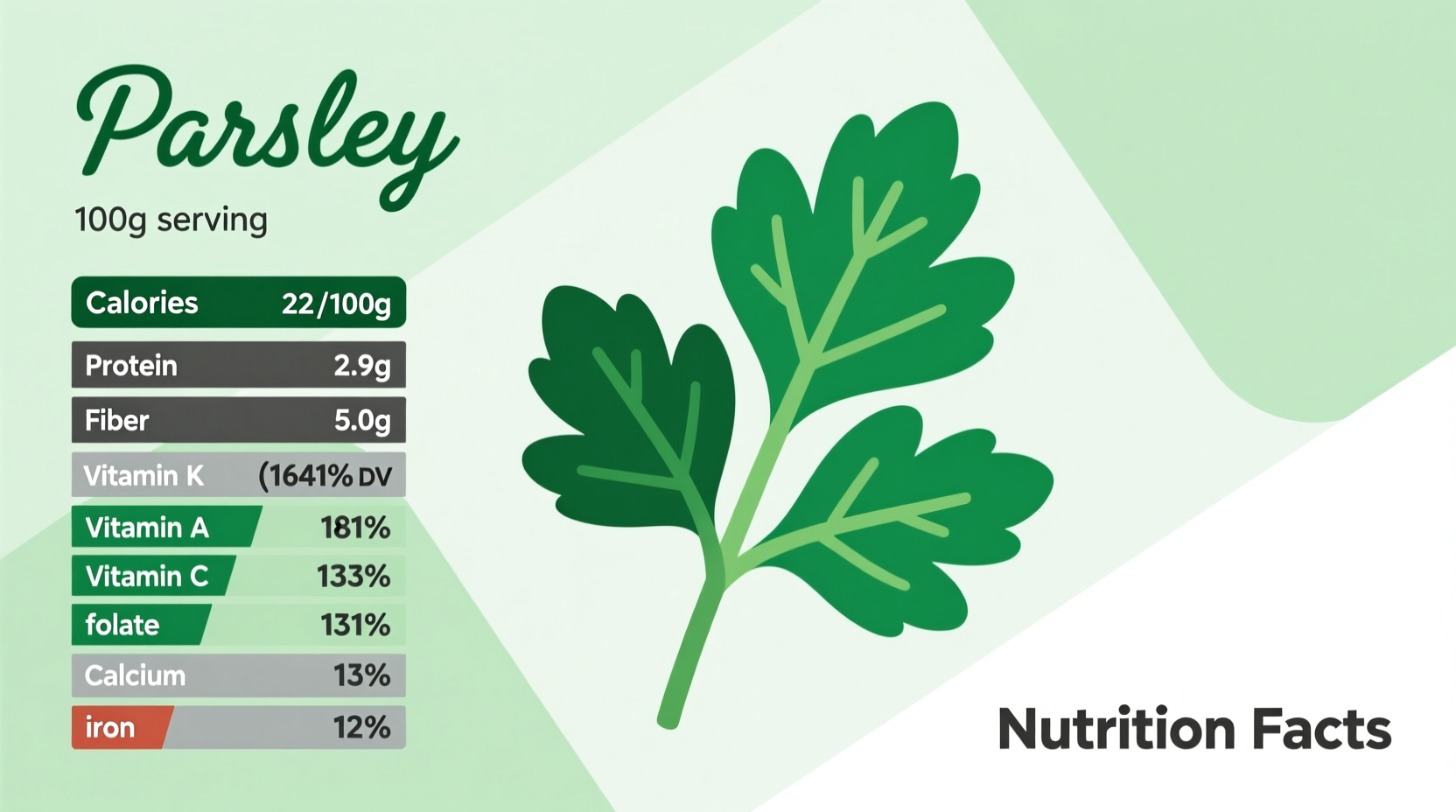One cup (60g) of fresh parsley delivers 984% of your daily vitamin K needs, 133% of vitamin C, and just 22 calories. This nutrient-dense herb contains powerful antioxidants like flavonoids and carotenoids that support bone health, immunity, and inflammation reduction. For optimal nutrient retention, consume parsley raw in salads or as a finishing garnish rather than cooking it extensively.
Discover why this humble kitchen staple deserves a starring role in your diet. Beyond its decorative reputation, parsley packs a serious nutritional punch that outperforms many fruits and vegetables in key nutrient categories. Whether you're looking to boost your vitamin intake, enhance antioxidant consumption, or simply add more nutrient density to meals, understanding parsley's complete nutritional profile can transform how you use this versatile herb.
What Makes Parsley a Nutritional Powerhouse
Often relegated to a plate garnish, parsley actually belongs to the same family as carrots and celery (Apiaceae), sharing their impressive nutrient density. Unlike many herbs used primarily for flavor, parsley delivers substantial nutritional benefits in every sprig. The two main varieties—curly leaf and flat-leaf (Italian) parsley—offer similar nutritional profiles, though flat-leaf contains slightly higher concentrations of certain nutrients due to its larger leaf surface area.
| Nutrient | Per 100g | Daily Value % | Key Functions |
|---|---|---|---|
| Calories | 36 kcal | 2% | Energy provision |
| Vitamin K | 1,640 mcg | 1,367% | Blood clotting, bone metabolism |
| Vitamin C | 133 mg | 148% | Immunity, collagen synthesis |
| Vitamin A | 4,210 IU | 84% | Vision, immune function |
| Folate | 152 mcg | 38% | Cell division, DNA synthesis |
| Iron | 6.2 mg | 34% | Oxygen transport, energy metabolism |
Data sourced from USDA FoodData Central (2023) shows that parsley's nutritional density per calorie surpasses many commonly consumed vegetables. This nutrient profile makes it particularly valuable for those seeking to maximize micronutrient intake without adding significant calories.
Vitamin K: Parsley's Standout Nutrient
Parsley's extraordinary vitamin K content deserves special attention. Just one-quarter cup (15g) of fresh parsley provides more than your entire daily requirement. Vitamin K plays a crucial role in:
- Blood coagulation and wound healing
- Bone mineralization and osteoporosis prevention
- Cardiovascular health through calcium regulation
- Brain function and cognitive preservation
Research published in the National Institutes of Health indicates that adequate vitamin K intake correlates with reduced fracture risk and improved bone density, particularly important for aging populations. However, those on blood-thinning medications like warfarin should maintain consistent parsley consumption levels, as sudden increases could interfere with medication efficacy.

Antioxidant Profile: Beyond Basic Vitamins
Beyond its vitamin content, parsley contains several potent antioxidants that contribute to its health-promoting properties:
- Apigenin: A flavonoid with demonstrated anti-inflammatory and potential anti-cancer properties studied by researchers at the Mayo Clinic
- Lutein and beta-carotene: Carotenoids that protect eye health and reduce macular degeneration risk
- Myricetin: An antioxidant showing promise in blood sugar regulation according to NIH studies
These compounds work synergistically to combat oxidative stress, which contributes to chronic diseases and aging. Unlike isolated supplements, consuming these compounds in their natural food matrix enhances bioavailability and effectiveness.
Parsley in Context: Practical Consumption Guidelines
While parsley's nutrient density is impressive, understanding appropriate consumption levels ensures you maximize benefits while avoiding potential issues:
- Optimal daily intake: 1-2 tablespoons chopped (3-6g) for general health maintenance
- Therapeutic amounts: Up to 1 cup chopped (60g) for targeted vitamin K or C boosting
- Preparation matters: Raw consumption preserves heat-sensitive nutrients like vitamin C
- Storage tips: Keep stems in water like flowers, refrigerated, for up to one week to maintain nutrient levels
Unlike many vegetables, parsley's nutrient profile remains stable during short-term refrigeration. A 2018 study in Food Chemistry demonstrated that parsley stored properly retained over 90% of its vitamin C content after seven days—significantly better than many leafy greens.
How Parsley Compares to Other Culinary Herbs
When evaluating herbs for nutritional value, parsley stands apart from its culinary companions:
- vs Cilantro: Parsley contains 3x more vitamin K and 50% more vitamin C
- vs Basil: Higher in iron and vitamin A, though basil contains more calcium
- vs Mint: Significantly higher in vitamins K and C, though mint offers different phytonutrients
- vs Dill: Comparable vitamin C, but parsley has 8x more vitamin K
This comparative advantage makes parsley particularly valuable as a daily dietary addition, especially for those seeking to boost specific micronutrients without supplementation.
Integrating Parsley into Your Daily Routine
Maximize parsley's nutritional benefits with these practical strategies:
- Morning green boost: Blend 2 tablespoons into smoothies (vitamin K is fat-soluble, so pair with avocado or nuts)
- Salad foundation: Use as 50% of your salad greens rather than just a garnish
- Soup finisher: Stir in fresh parsley just before serving to preserve nutrients
- Herb oil infusion: Create nutrient-rich oil by steeping in olive oil for salad dressings
- Parsley pesto: Substitute half the basil in pesto recipes for enhanced nutrition
Professional chefs like those at leading culinary institutions have shifted from viewing parsley as mere decoration to recognizing it as a nutritional ingredient worthy of prominence. This evolution in culinary thinking reflects growing awareness of its substantial health benefits.
Special Considerations and Context Boundaries
While parsley offers numerous benefits, certain populations should exercise moderation:
- Kidney concerns: Those with kidney disease should monitor intake due to potassium content (approx. 554mg per 100g)
- Pregnancy: Moderate consumption is safe, but medicinal amounts may stimulate uterine contractions
- Medication interactions: High vitamin K content may affect blood thinners—maintain consistent intake levels
- Allergies: Rare, but possible for those with Apiaceae family sensitivities (carrots, celery)
These context boundaries highlight why understanding your personal health circumstances matters when incorporating nutrient-dense foods like parsley into your regular diet.
Historical Evolution of Parsley Consumption
Parsley's journey from ancient medicinal herb to modern kitchen staple reveals much about its nutritional value:
- Ancient Greece (5th century BCE): Used primarily for medicinal purposes and as victory wreaths
- Roman Empire: Employed as both culinary herb and breath freshener after meals
- Middle Ages: Recognized in European herbals for treating kidney and digestive issues
- 19th century: Documented in medical texts for treating jaundice and urinary tract issues
- Modern era: Scientific validation of traditional uses through nutritional analysis
This historical timeline demonstrates how traditional knowledge often preceded scientific validation—a pattern seen with many nutrient-dense plants. Modern research continues to confirm many traditional uses of parsley, particularly regarding kidney health and inflammation reduction.
Maximizing Nutrient Retention: Preparation Science
How you handle parsley significantly impacts its nutritional value:
- Cutting technique: Chop just before use—premature cutting accelerates nutrient loss
- Heat exposure: Vitamin C degrades rapidly above 70°C (158°F)—add at end of cooking
- Fat pairing: Vitamin K absorption increases 3-5x when consumed with healthy fats
- Acid preservation: Lemon juice in tabbouleh helps preserve vitamin C content
Understanding these preparation principles transforms how you incorporate parsley into meals, ensuring you receive maximum nutritional benefit from each sprig.
How much parsley should I eat daily for health benefits?
For general health maintenance, 1-2 tablespoons (3-6g) of fresh parsley daily provides significant nutritional benefits without risk. Those seeking therapeutic vitamin K or C boosting can safely consume up to 1 cup chopped (60g) daily, though individuals on blood thinners should maintain consistent intake levels.
Is dried parsley as nutritious as fresh parsley?
Dried parsley retains some nutrients but loses significant amounts of heat-sensitive vitamins like vitamin C during the drying process. Fresh parsley contains approximately 133mg of vitamin C per 100g, while dried contains only about 30mg. Vitamin K remains relatively stable in dried form, making it still valuable for this nutrient.
Can parsley help with inflammation?
Yes, parsley contains several anti-inflammatory compounds including apigenin, luteolin, and vitamin C. Research published in the Journal of Agricultural and Food Chemistry shows these compounds inhibit inflammatory pathways. Regular consumption as part of a balanced diet may help reduce chronic inflammation markers.
Why does parsley make my urine smell?
Parsley contains asparagine, an amino acid that breaks down into compounds processed by your kidneys. This natural metabolic process can cause a temporary, harmless change in urine odor similar to asparagus consumption. The effect varies by individual based on genetic factors affecting metabolism.
Does cooking parsley destroy its nutrients?
Cooking affects different nutrients variably. Heat-sensitive vitamins like C degrade significantly with prolonged cooking, while vitamin K and certain antioxidants remain stable. For maximum nutrient retention, add parsley during the last 1-2 minutes of cooking or use raw in salads and dressings. Steaming preserves more nutrients than boiling.











 浙公网安备
33010002000092号
浙公网安备
33010002000092号 浙B2-20120091-4
浙B2-20120091-4